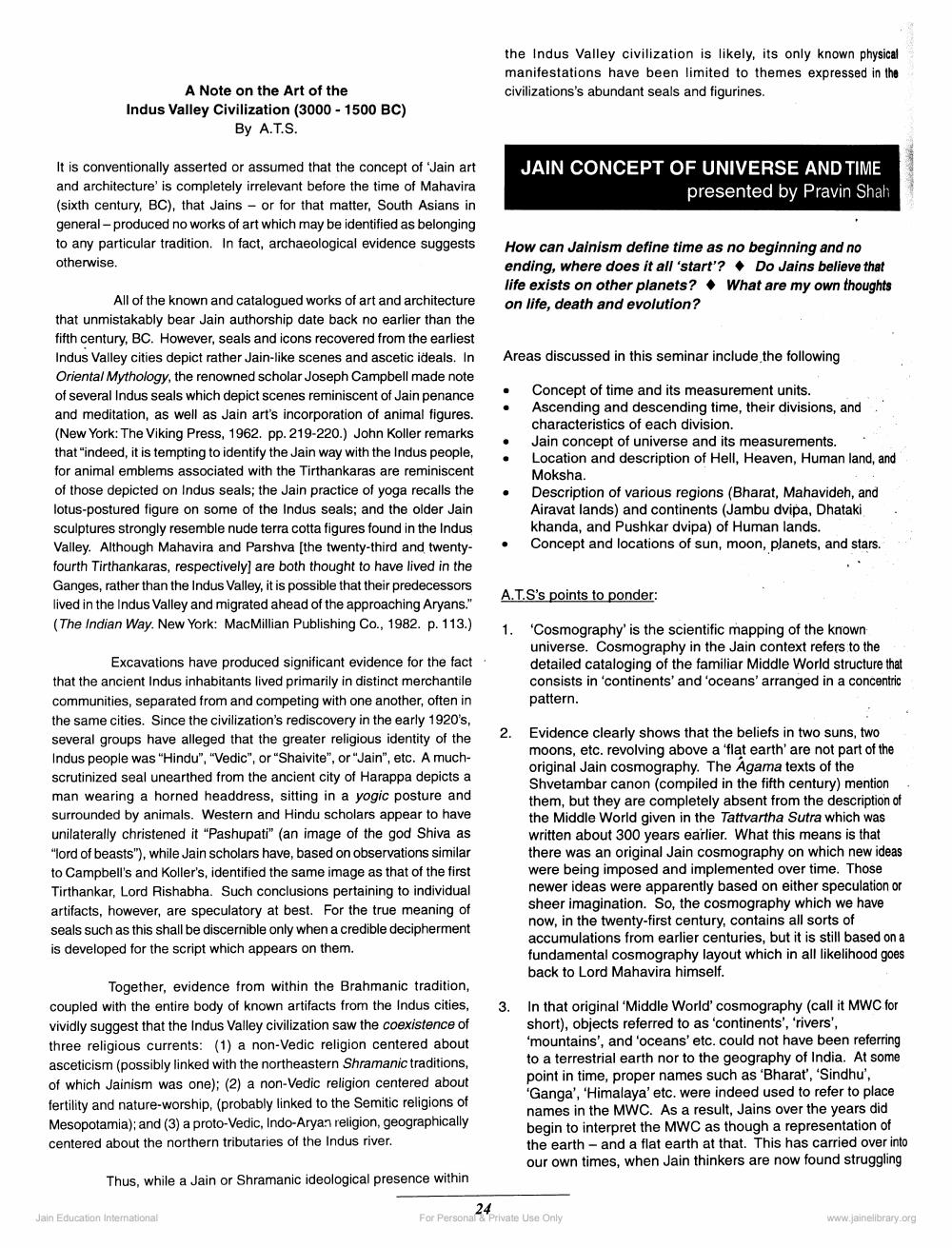________________
A Note on the Art of the Indus Valley Civilization (3000 - 1500 BC) By A.T.S.
It is conventionally asserted or assumed that the concept of 'Jain art and architecture' is completely irrelevant before the time of Mahavira (sixth century, BC), that Jains or for that matter, South Asians in general-produced no works of art which may be identified as belonging to any particular tradition. In fact, archaeological evidence suggests otherwise.
All of the known and catalogued works of art and architecture that unmistakably bear Jain authorship date back no earlier than the fifth century, BC. However, seals and icons recovered from the earliest Indus Valley cities depict rather Jain-like scenes and ascetic ideals. In Oriental Mythology, the renowned scholar Joseph Campbell made note of several Indus seals which depict scenes reminiscent of Jain penance and meditation, as well as Jain art's incorporation of animal figures. (New York: The Viking Press, 1962. pp. 219-220.) John Koller remarks that "indeed, it is tempting to identify the Jain way with the Indus people, for animal emblems associated with the Tirthankaras are reminiscent of those depicted on Indus seals; the Jain practice of yoga recalls the lotus-postured figure on some of the Indus seals; and the older Jain sculptures strongly resemble nude terra cotta figures found in the Indus Valley. Although Mahavira and Parshva [the twenty-third and twentyfourth Tirthankaras, respectively] are both thought to have lived in the Ganges, rather than the Indus Valley, it is possible that their predecessors lived in the Indus Valley and migrated ahead of the approaching Aryans." (The Indian Way. New York: MacMillian Publishing Co., 1982. p. 113.)
Excavations have produced significant evidence for the fact that the ancient Indus inhabitants lived primarily in distinct merchantile communities, separated from and competing with one another, often in the same cities. Since the civilization's rediscovery in the early 1920's, several groups have alleged that the greater religious identity of the Indus people was "Hindu", "Vedic", or "Shaivite", or "Jain", etc. A muchscrutinized seal unearthed from the ancient city of Harappa depicts a man wearing a horned headdress, sitting in a yogic posture and surrounded by animals. Western and Hindu scholars appear to have unilaterally christened it "Pashupati" (an image of the god Shiva as "lord of beasts"), while Jain scholars have, based on observations similar to Campbell's and Koller's, identified the same image as that of the first Tirthankar, Lord Rishabha. Such conclusions pertaining to individual artifacts, however, are speculatory at best. For the true meaning of seals such as this shall be discernible only when a credible decipherment is developed for the script which appears on them.
Together, evidence from within the Brahmanic tradition, coupled with the entire body of known artifacts from the Indus cities, vividly suggest that the Indus Valley civilization saw the coexistence of three religious currents: (1) a non-Vedic religion centered about asceticism (possibly linked with the northeastern Shramanic traditions, of which Jainism was one); (2) a non-Vedic religion centered about fertility and nature-worship, (probably linked to the Semitic religions of Mesopotamia); and (3) a proto-Vedic, Indo-Aryan religion, geographically centered about the northern tributaries of the Indus river.
Thus, while a Jain or Shramanic ideological presence within
Jain Education International
the Indus Valley civilization is likely, its only known physical manifestations have been limited to themes expressed in the civilizations's abundant seals and figurines.
JAIN CONCEPT OF UNIVERSE AND TIME presented by Pravin Shati
How can Jainism define time as no beginning and no ending, where does it all 'start'? Do Jains believe that life exists on other planets? What are my own thoughts
on life, death and evolution?
Areas discussed in this seminar include the following
Concept of time and its measurement units. Ascending and descending time, their divisions, and characteristics of each division.
Jain concept of universe and its measurements. Location and description of Hell, Heaven, Human land, and Moksha.
Description of various regions (Bharat, Mahavideh, and Airavat lands) and continents (Jambu dvipa, Dhataki khanda, and Pushkar dvipa) of Human lands. Concept and locations of sun, moon, planets, and stars.
A.T.S's points to ponder:
1. 'Cosmography' is the scientific mapping of the known
universe. Cosmography in the Jain context refers to the detailed cataloging of the familiar Middle World structure that consists in 'continents' and 'oceans' arranged in a concentric pattern.
2. Evidence clearly shows that the beliefs in two suns, two moons, etc. revolving above a 'flat earth' are not part of the original Jain cosmography. The Agama texts of the Shvetambar canon (compiled in the fifth century) mention them, but they are completely absent from the description of the Middle World given in the Tattvartha Sutra which was written about 300 years earlier. What this means is that there was an original Jain cosmography on which new ideas were being imposed and implemented over time. Those newer ideas were apparently based on either speculation or sheer imagination. So, the cosmography which we have now, in the twenty-first century, contains all sorts of accumulations from earlier centuries, but it is still based on a fundamental cosmography layout which in all likelihood goes back to Lord Mahavira himself.
3. In that original 'Middle World' cosmography (call it MWC for short), objects referred to as 'continents', 'rivers', 'mountains', and 'oceans' etc. could not have been referring to a terrestrial earth nor to the geography of India. At some point in time, proper names such as 'Bharat', 'Sindhu', 'Ganga', 'Himalaya' etc. were indeed used to refer to place names in the MWC. As a result, Jains over the years did begin to interpret the MWC as though a representation of the earth and a flat earth at that. This has carried over into our own times, when Jain thinkers are now found struggling
24
For Personal Private Use Only
www.jainelibrary.org




